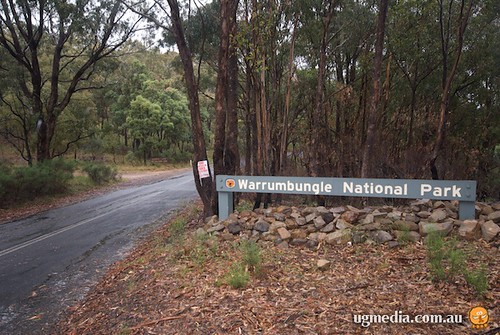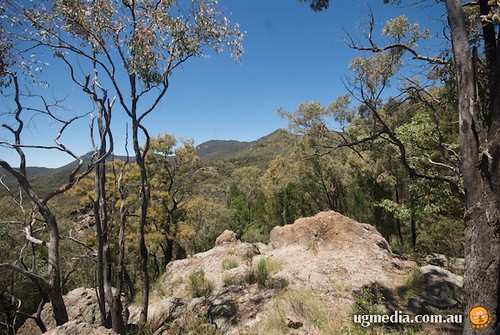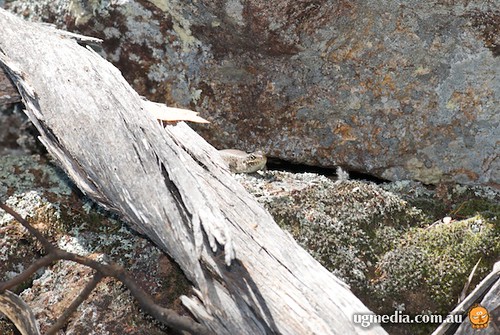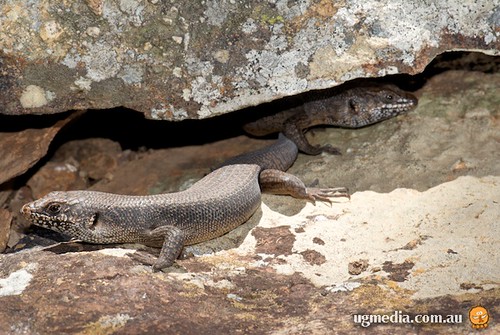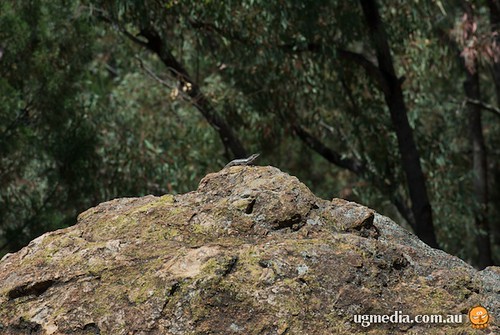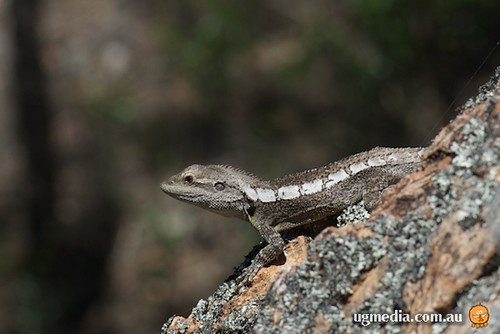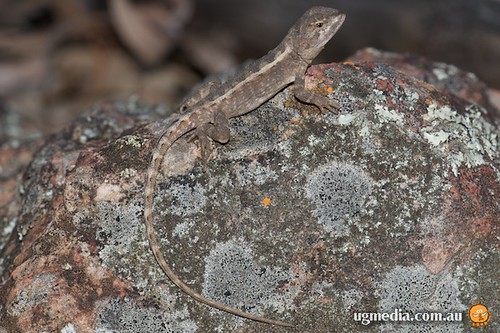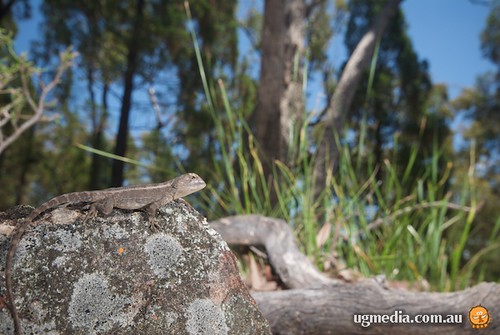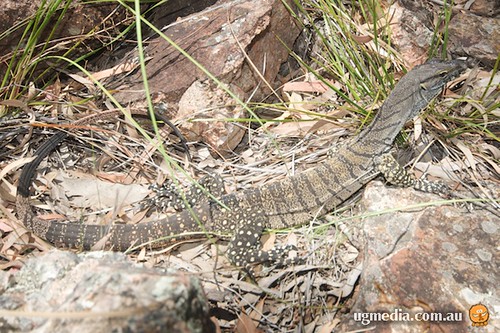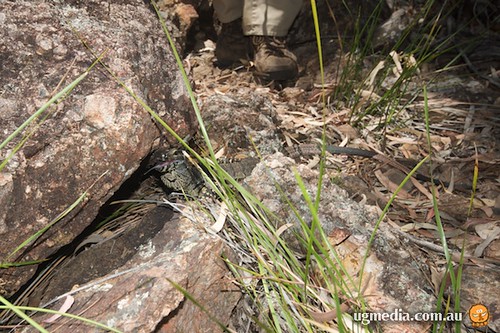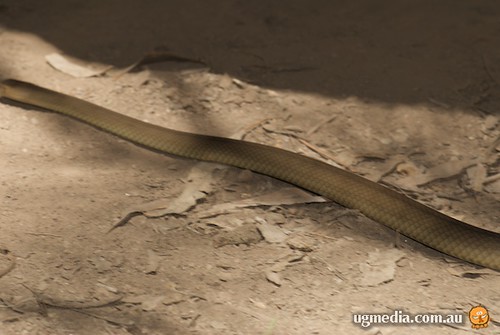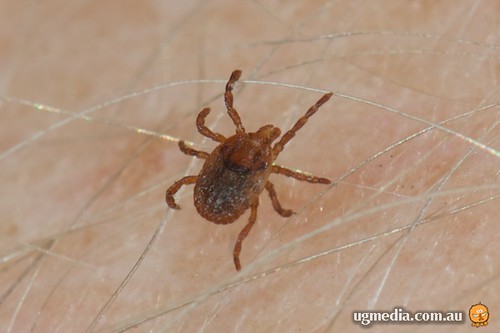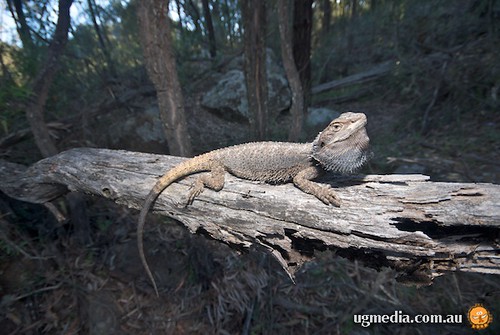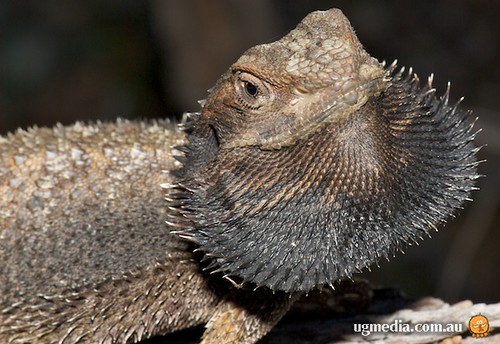smacdonald
Well-Known Member
Copied directly from my blog, so excuse the weird date references. This story takes place on the 8th and 9th of November, 2008. Let me know if I've misidentified anything.
--
We left Mudgee and headed towards Warrumbungle National Park. Along the way we saw an eastern long-necked turtle on the side of the road.
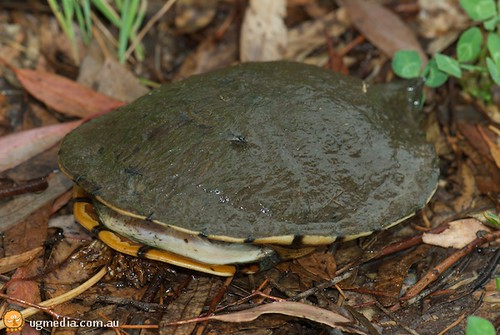
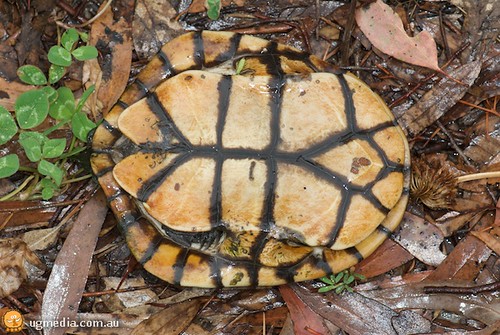
Eastern long-necked turtle (Chelodina longicollis). She was alive on the road. We moved her off (after looking at her plastron to confirm her ID).
Eventually we arrived at the park.
Unfortunately it was cold, wet, cold, miserable, cold and wet. I shivered in the car while waiting for the sun to come out. 18 hours later, the sun was shining brightly. We walked up the Goulds Circuit track, stopping to have a look at a rocky outcrop.
It didn't take long before we found the first reptile of the day - a White's skink (Egernia whitii).
As we poked around, we found a number of other White's skinks, which gradually got used to us and let us get close enough to photograph them.
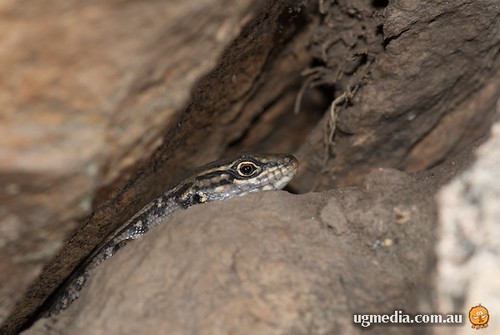
White's skink (Egernia whitii)
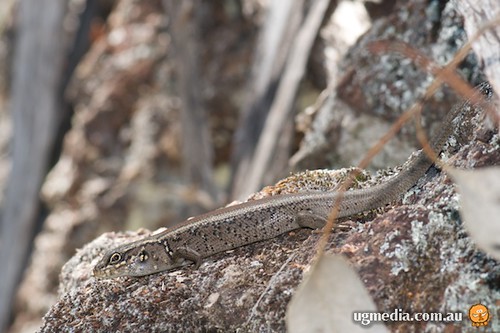
White's skink (Egernia whitii)
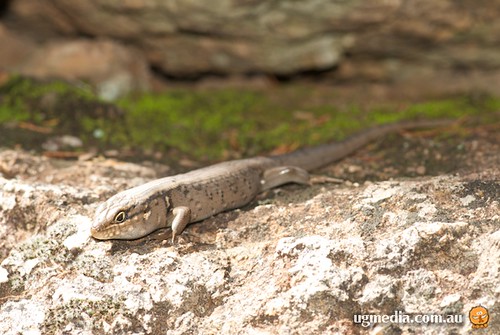
White's skink (Egernia whitii)
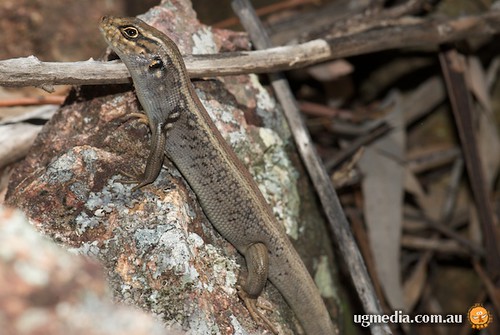
White's skink (Egernia whitii)
The rocky crevices were also home to black rock skinks (Egernia saxatilis saxatilis).
We saw a number of other skinks around the place, too.
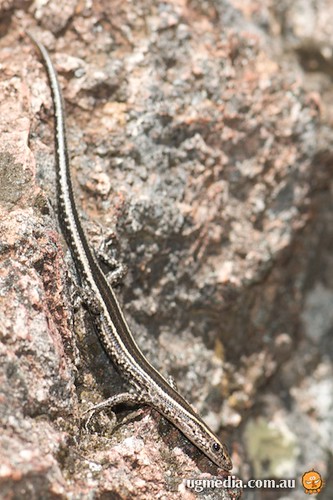
Cryptoblepharus pulcher
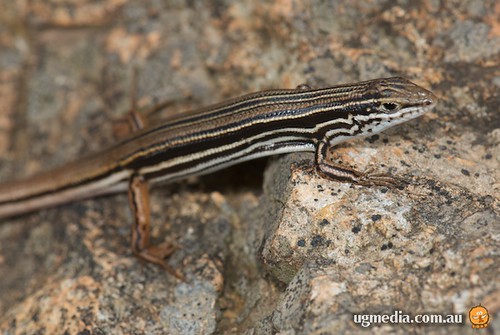
Copper-tailed skink (Ctenotus taeniolatus)
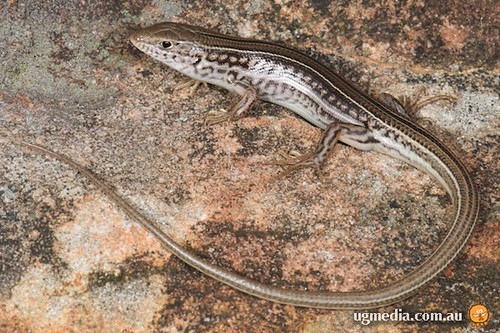
Eastern robust skink (Ctenotus robustus)
We saw a lone jacky dragon (Amphibolurus muricatus) head bobbing and arm waving on a rock in the distance.
As we approached him, he continued to arm wave and bob his head as he moved away from us.
We also found a little mountain heath dragon (Rankinia diemensis) running around and sunning himself.
As I was photographing the mountain dragon, my travelling companion called out to tell me he'd seen a lace monitor (Varanus varius) patrolling the outcrop.
This goanna was very bold for his size, and continued to ignore us as we got closer and closer to him. He was sniffing around the rocks, looking for food. He eventually found what I assume were lizard eggs, and ate a few of them while we watched.
After exhausting the supply of lizards on the top of the mountain, we started walking back down. Richard asked (somewhat rhetorically) "Where are all the snakes that are eating these lizards?". Exactly 2.48 seconds later, an eastern brown snake (Pseudonaja textilis) slithered away from the path a couple of metres in front of us. It was very fast, so this was the only photo I managed to get of it.
As we continued walking back to the car park we noticed a small Egernia on a fallen tree. It looked like a tree skink (Egernia striolata), but it hid before we got to take a picture. We sat down and waited for him to come back out again. While waiting, I found a little eight-legged friend on my arm.
The possible tree skink didn't show his face again. We went back the next morning to have a look, but again he dashed out of view before we got close enough to identify or photograph it.
We saw a number of eastern bearded dragons (Pogona barbata) sunning themselves on the roads throughout the park. This one ran up a nearby log as we got out of the car to look at him.
At night it was still cold (did I mention the cold?) and wet. We drove along the road anyway, to see what we could see. We found some frogs, but I refused to leave the warmth of the car so all I have is this artist's impression of said amphibian:

Artist's rendering of a frog
Eastern grey kangaroos (Macropus giganteus) were plentiful in the park. They were tiny little midget roos. I saw a number of small female roos (with pouch young, so they were obviously adults) that were almost the same size as juvenile roos I've seen up here around Brisbane. I reckon the cold, wet conditions (did I mention it was cold and wet?) must be stunting their growth.
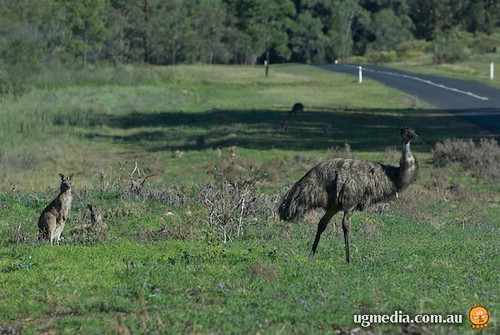
Eastern grey kangaroo (Macropus giganteus) and emu (Dromaius novaehollandiae)
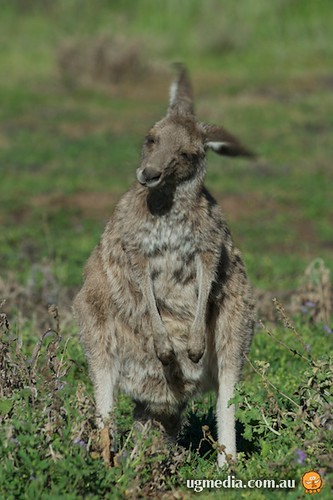
Eastern grey kangaroo (Macropus giganteus)
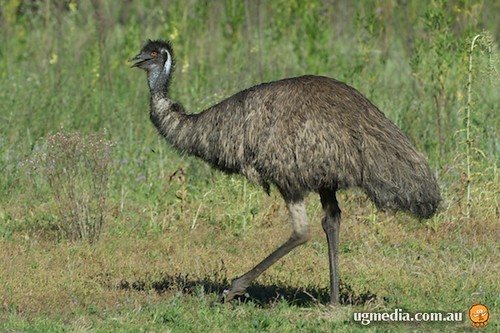
Emu (Dromaius novaehollandiae)
Two sleepless nights of extreme cold were all we could handle, so we packed up and headed to our next destination, Girraween National Park just across the border in Queensland.
--
We left Mudgee and headed towards Warrumbungle National Park. Along the way we saw an eastern long-necked turtle on the side of the road.


Eastern long-necked turtle (Chelodina longicollis). She was alive on the road. We moved her off (after looking at her plastron to confirm her ID).
Eventually we arrived at the park.
Unfortunately it was cold, wet, cold, miserable, cold and wet. I shivered in the car while waiting for the sun to come out. 18 hours later, the sun was shining brightly. We walked up the Goulds Circuit track, stopping to have a look at a rocky outcrop.
It didn't take long before we found the first reptile of the day - a White's skink (Egernia whitii).
As we poked around, we found a number of other White's skinks, which gradually got used to us and let us get close enough to photograph them.

White's skink (Egernia whitii)

White's skink (Egernia whitii)

White's skink (Egernia whitii)

White's skink (Egernia whitii)
The rocky crevices were also home to black rock skinks (Egernia saxatilis saxatilis).
We saw a number of other skinks around the place, too.

Cryptoblepharus pulcher

Copper-tailed skink (Ctenotus taeniolatus)

Eastern robust skink (Ctenotus robustus)
We saw a lone jacky dragon (Amphibolurus muricatus) head bobbing and arm waving on a rock in the distance.
As we approached him, he continued to arm wave and bob his head as he moved away from us.
We also found a little mountain heath dragon (Rankinia diemensis) running around and sunning himself.
As I was photographing the mountain dragon, my travelling companion called out to tell me he'd seen a lace monitor (Varanus varius) patrolling the outcrop.
This goanna was very bold for his size, and continued to ignore us as we got closer and closer to him. He was sniffing around the rocks, looking for food. He eventually found what I assume were lizard eggs, and ate a few of them while we watched.
After exhausting the supply of lizards on the top of the mountain, we started walking back down. Richard asked (somewhat rhetorically) "Where are all the snakes that are eating these lizards?". Exactly 2.48 seconds later, an eastern brown snake (Pseudonaja textilis) slithered away from the path a couple of metres in front of us. It was very fast, so this was the only photo I managed to get of it.
As we continued walking back to the car park we noticed a small Egernia on a fallen tree. It looked like a tree skink (Egernia striolata), but it hid before we got to take a picture. We sat down and waited for him to come back out again. While waiting, I found a little eight-legged friend on my arm.
The possible tree skink didn't show his face again. We went back the next morning to have a look, but again he dashed out of view before we got close enough to identify or photograph it.
We saw a number of eastern bearded dragons (Pogona barbata) sunning themselves on the roads throughout the park. This one ran up a nearby log as we got out of the car to look at him.
At night it was still cold (did I mention the cold?) and wet. We drove along the road anyway, to see what we could see. We found some frogs, but I refused to leave the warmth of the car so all I have is this artist's impression of said amphibian:

Artist's rendering of a frog
Eastern grey kangaroos (Macropus giganteus) were plentiful in the park. They were tiny little midget roos. I saw a number of small female roos (with pouch young, so they were obviously adults) that were almost the same size as juvenile roos I've seen up here around Brisbane. I reckon the cold, wet conditions (did I mention it was cold and wet?) must be stunting their growth.

Eastern grey kangaroo (Macropus giganteus) and emu (Dromaius novaehollandiae)

Eastern grey kangaroo (Macropus giganteus)

Emu (Dromaius novaehollandiae)
Two sleepless nights of extreme cold were all we could handle, so we packed up and headed to our next destination, Girraween National Park just across the border in Queensland.




